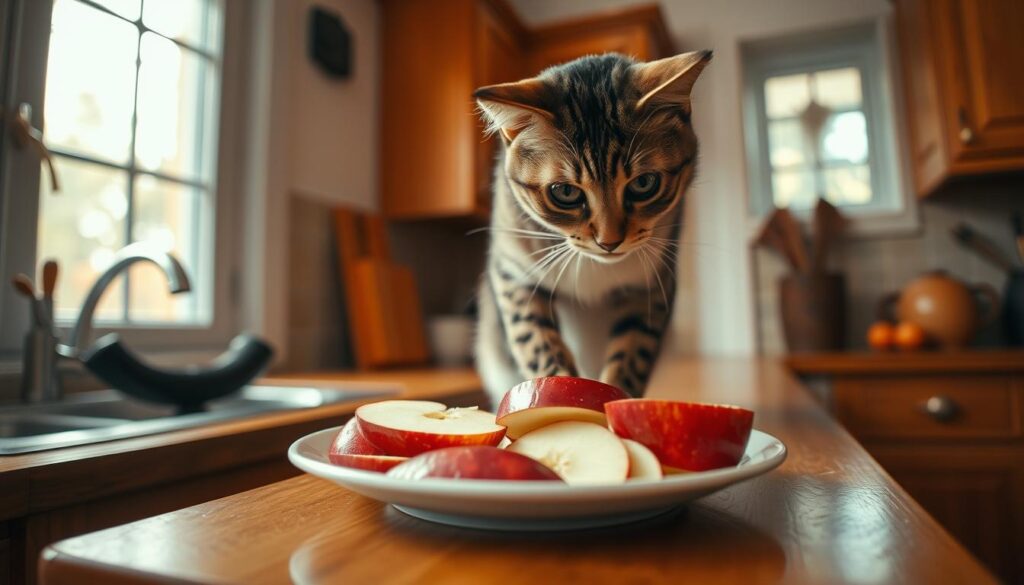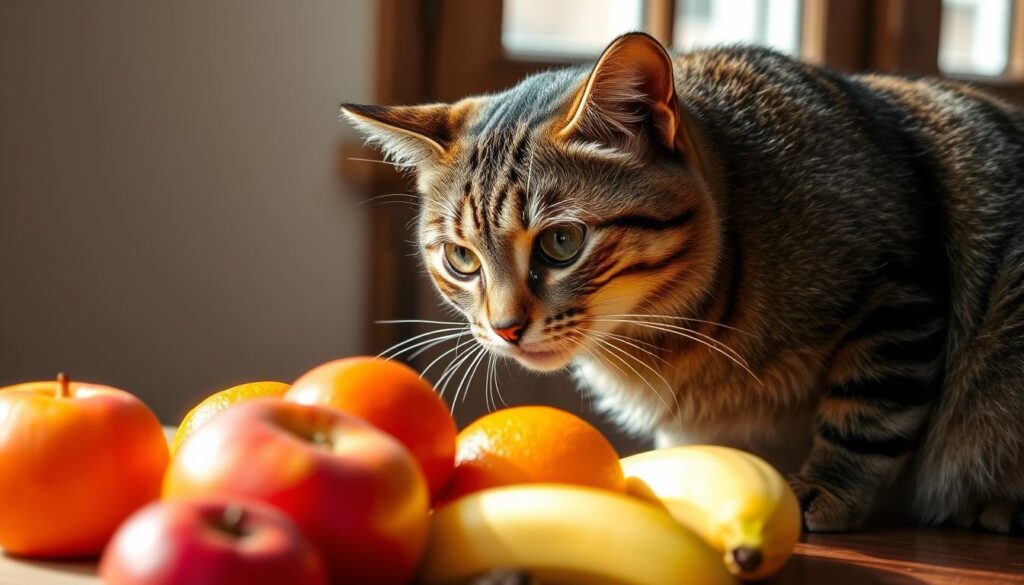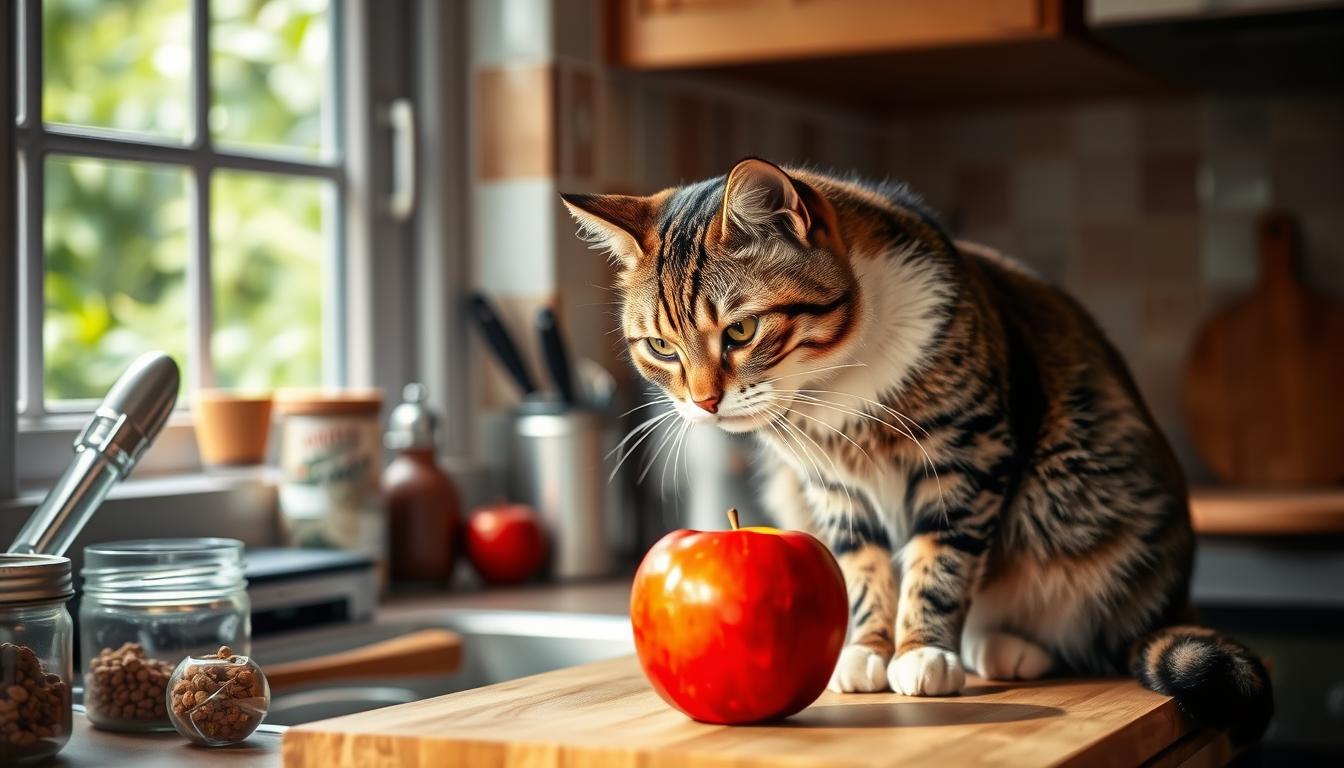can cats eat appeles: Ever shared a snack with your cat and hesitated? You’re not alone. Apples might be good for you, but are they safe for your cat? Apple flesh isn’t toxic, but the seeds, stems, and core are different. If your cat eats a seed, it could be dangerous.
Even the sugar and fiber in apples can upset a cat’s stomach. It’s like a big risk for a small snack.
As a pet parent, you want to make safe choices. Apples have vitamins A and C, but cats don’t need them. The USDA says apples don’t have what cats need.
So, can cats eat apples safely? It depends on how you give them to your cat. A tiny, seed-free piece might be okay. But, you need to be careful about the risks of overfeeding or toxic parts.
Key Takeaways
- Apple flesh isn’t toxic, but seeds, stems, and cores contain cyanide.
- Cats lack enzymes to process apple sugars and fiber well.
- Only tiny, peeled, seedless pieces are safe as rare treats.
- Apples add no essential nutrients to a cat’s meat-based diet.
- Large amounts or toxic parts can cause vomiting, breathing issues, or worse.
Understanding Your Cat’s Dietary Needs
Before adding apples to your cat’s meals, understand their unique biology. cat nutrition and apples must meet their natural carnivorous needs. Their bodies need meat, not plant-based foods like fruits.
“Apple seeds, stems, and leaves contain cyanide-producing compounds. Always remove these before offering any part of the apple to your cat.” — ASPCA
Cats as Obligate Carnivores
Cats can’t live on vegetarian or fruit diets. They lack enzymes to digest plant fibers well. Their wild ancestors hunted for meat, which is rich in protein and nutrients.
The Role of Fruits in Feline Nutrition
Fruits like apples aren’t part of a feline diet apples or other produce. Apple flesh has vitamins C and K, but cats make their own vitamin C. Too much sugar in apples can lead to obesity or diabetes in cats.
Nutritional Requirements of Domestic Cats
Cats need:
- 45%+ protein from animal sources
- taurine to prevent heart disease
- niacin and arginine for enzyme function
More than 90% of their diet should be high-quality commercial cat food. Treats like fruit should never be more than 10% of their daily food. Sudden changes in diet can upset their stomach or cause nutrient deficiencies.
Can Cats Eat Apples? The Definitive Answer
Yes, cats can have small amounts of apple flesh as a treat sometimes. But, it’s important to be careful. Make sure to remove all seeds, stems, and cores before giving any apple to your cat.
- Safe parts: Only the crisp, peeled apple flesh in tiny portions.
- Unsafe parts: Seeds, stems, and cores contain cyanide compounds that are toxic to cats.
Even safe apple pieces should be given rarely. A small bite-sized piece occasionally is okay. But, never make apples a regular part of their diet. Cats need protein-rich foods, not fruits, for optimal health.
Veterinarians agree that while apples aren’t harmful in strict moderation, they offer no nutritional benefits to cats.
Always talk to your vet before introducing new foods. Stick to your cat’s regular diet. Use apples only as an occasional, carefully prepared treat.
Nutritional Profile of Apples
Apples have vitamins, fiber, and antioxidants, but cats don’t need them. A 100-gram serving has 2.4g fiber, 10g natural sugar, and vitamins C and K. It also has potassium and antioxidants. But, cats get these nutrients from their protein-rich diets.
Key Vitamins and Minerals in Apples
Apples have vitamin C, which helps immunity. But cats make their own. Potassium is good for muscles, and cat foods have enough. Antioxidants help slow aging, but cats don’t need apples for this.
Fiber Content and Digestibility
Fiber in apples can help with hairballs and digestion. But too much can cause diarrhea or stomach problems. Give small, seedless pieces to avoid choking or upset stomach.
Sugar Content: Considerations for Cats
Apples have 10g sugar per 100g, making them not low-calorie treats. Too much sugar can lead to obesity and blood sugar spikes. Diabetic cats are especially at risk. Always give small amounts and check with a vet first.
Potential Benefits of Apples for Felines
Apples can offer some minor health benefits for cats if given correctly. They have fiber that helps with digestion and might ease hairballs. Vitamins A, C, and K in apples also support the immune system, eyes, and blood clotting. But, cats mainly get what they need from meat.
| Nutrient | Role in Cat Health |
|---|---|
| Fiber | Aids digestion and gut motility |
| Vitamin A | Promotes eye and immune health |
| Vitamin C | Acts as an antioxidant, reducing oxidative stress |
| Potassium | Supports muscle and nerve function |
| Antioxidants | May slow cell damage and inflammation |
Some cats like the crunchy texture of apple pieces as a treat. Apple flesh has natural sugars that are better than sugary treats. But, these benefits are small for cats that need a lot of protein.
- Hydration boost from apple’s moisture content
- Possible dental stimulation from chewing
- Phytonutrients in apple skin may reduce inflammation
Remember, apples should not make up more than 10% of a cat’s daily calories. Too much can upset their stomach. Make sure to remove the core, seeds, and stems to avoid cyanide. Talk to your vet before adding apples to your cat’s diet.
Risks and Dangers: Apple Toxicity in Cats
Apples have some good vitamins, but their toxic parts need careful handling. If your cat eats seeds, stems, or leaves, it can get sick. Make sure to prepare apples safely to keep your cat away from danger.
Apple Seeds and Cyanide Concerns
Apple seeds have amygdalin, which turns into cyanide when crushed or eaten. This toxin can harm blood oxygen flow, leading to poisoning. Even a small amount of seeds can cause stomach problems, and eating a lot can be very dangerous.
Always throw away seeds, stems, and leaves to avoid poisoning.
Choking and Digestive Hazards
Whole apples or big chunks can choke your cat. Too much sugar or fiber in apple flesh can upset their stomach or cause diarrhea. To keep your cat safe, cut apples into tiny, seed-free pieces. Don’t give them juice, as it has added sugars that are bad for their stomach.
Signs of Adverse Reactions to Watch For
Look out for these signs after your cat eats an apple:
- Vomiting, diarrhea, or loss of appetite
- Labored breathing or rapid panting
- Weakness, unresponsiveness, or discolored gums
- Unusal drooling or sudden lethargy
“The ASPCA Animal Poison Control Center advises immediate vet care if your cat eats toxic apple parts. Call (888) 426-4435 for 24/7 assistance.”
If you see any of these symptoms, call the ASPCA or your vet right away. Quick action can help your cat get better. Always keep apples out of your cat’s reach and watch them closely after treats.
How to Safely Introduce Apples to Your Cat’s Diet
Introducing apples to your cat’s diet needs to be safe and in moderation. Follow these steps to make feeding cats apples a safe, occasional treat.
Proper Preparation Methods
- Wash apples well to remove pesticides and dirt.
- Take out seeds, core, and stem to avoid cyanide risks.
- Peel the apple if your cat has sensitive digestion.
- Cut the flesh into ¼-inch cubes to prevent choking.

Recommended Serving Sizes
- Give no more than 1-2 small pieces at a time.
- Make sure they get 10% of their daily calories—about 5-10 calories total.
- Kittens under 6 months should avoid apples; stick to kitten food.
Frequency Guidelines
Apples should be an occasional treat. Offer:
- Once or twice weekly, maximum.
- Watch for vomiting or diarrhea after each serving.
- Stop immediately if your cat shows discomfort.
Always adjust their regular meal portions to account for added calories. Cats with diabetes or obesity should avoid apples. Consult your vet before introducing new foods.
Apple Alternatives: Other Safe Fruits for Cats
There are other fruits for cats besides apples that can be given as treats. Make sure your cat eats high-quality protein first. But, adding fruits now and then can be fun.
- Bananas: Rich in potassium but low in sugar. Remove the peel and serve in tiny slices.
- Blueberries: Packed with antioxidants. Offer a few washed berries as a crunchy snack.
- Watermelon: Seedless and high in hydration. Discard rinds and seeds before serving.
- Raspberries: Small amounts only—contains natural sugar and fiber.
“While fruits aren’t nutritionally necessary for cats, properly prepared options like blueberries or peeled apple pieces can be safe in strict moderation,” says Dr. Emily Carter, a feline nutritionist.
Avoid grapes, raisins, avocado, and citrus—these are toxic and can cause severe illness. Always peel, seed, and dice fruits into pea-sized pieces to prevent choking.
Give only 1–2 small pieces a week. Watch for signs of upset stomach or allergies like vomiting or itching. Always get vet advice before adding fruits for cats to their diet.
What Veterinarians Say About Cats and Fruit Consumption
Veterinarians warn that cats fruit consumption needs careful thought. They say cats must eat protein-rich foods because they are obligate carnivores. Dr. Jane Collins, a feline nutrition expert, notes, “Fruits don’t give cats essential nutrients. But, small amounts of fruits like blueberries or peeled apples can be okay as treats.”

Expert Opinions on Feline Diets
Top vet groups like the American Animal Hospital Association share important advice:
- Fruits should never be a substitute for meat.
- Make sure to remove seeds, stems, and pits—apple seeds have cyanide.
- Cats don’t need carbs or fruit sugars in their diet.
When to Consult Your Vet
Before giving fruits to your cat, talk to your vet if:
- Your cat has diabetes, kidney disease, or obesity.
- They have digestive problems after eating fruits before.
- They vomit, have diarrhea, or seem tired after trying new foods.
Remember, cats fruit consumption must fit your pet’s health needs. Always choose commercial cat foods that meet AAFCO standards for full nutrition. If unsure, get expert advice before changing your cat’s diet.
Common Myths About Cats and Apples Debunked
Many myths about safety of apples for cats spread online. Let’s address the most common ones:
- Myth 1: Apples cure bad breath.
Fact: Apples don’t replace brushing teeth or vet checkups. Dental health requires professional care. - Myth 2: Wild cats eat apples in the wild.
Fact: Feral cats are meat-eaters. Fruits aren’t part of their natural diet. - Myth 3: Organic apples are perfectly safe.
Fact: Even organic apples must be peeled and cored. Seeds and cores are always risky. - Myth 4: Apples hydrate cats like wet food.
Fact: Cats need meat-based diets for nutrients like taurine. Apples can’t replace protein sources.
“Only small amounts of apple flesh should be offered to cats, no more than 1-2 small slices weekly,” advises the ASPCA. Overfeeding can cause stomach upset.
Surveys show 15% of cat owners wrongly assume fruits are safe. Always consult your vet before introducing new foods. Remember, the safety of apples for cats depends on portion control and preparation. Prioritize your cat’s carnivore needs first.
Conclusion: Making Informed Choices About Your Cat’s Diet
When thinking about whether cats can eat apples, remember they should only be an occasional treat. Apples can be given in small, seedless pieces. But they should never replace their main food.
While apples might offer some fiber or vitamins, cats get most of their nutrients from animal proteins. Their bodies aren’t made to digest plant foods well. So, fruits like apples are best used as a supplement.
A cat’s diet should mainly include meat-based foods. These foods are rich in taurine and other amino acids. These nutrients are key for heart health and overall well-being, which apples can’t provide.
If you do give your cat apples, make sure to remove the seeds and cores. This is to avoid cyanide risks. Even then, only give small amounts to prevent digestive problems.
Vets say that 90% of a cat’s diet should come from high-quality cat food. Fruits like apples or blueberries can be rare treats. But using them too much can upset the balance. Always watch how your cat reacts and talk to a vet before adding new foods. Sticking to the right diet is key for your cat’s long-term health and safety.
FAQ
Can cats eat apples safely?
Are apples nutritionally beneficial for cats?
What parts of the apple should I avoid when feeding my cat?
How much apple can I give my cat as a treat?
Can apples help with my cat’s digestion?
Are there any risks associated with cats eating apples?
How do I prepare apples for my cat?
What other fruits are safe for cats?
Should I consult my veterinarian before offering fruits to my cat?
What are some misconceptions about cats eating apples?
Source Links
- Can Cats Eat Apples? Safe Tips for Pet Owners – https://michu.com.au/blogs/news/can-cats-eat-apples?srsltid=AfmBOopMYZTo9xF9KgUD1xbWJRNoyWw4FS0DE8dRvE8Pqx3Dx9bAqmoB
- Can Cats Eat Apples? Understanding The Benefits Of Fruit For Felines | Cat Boarding Hotel Laguna, Mission Viejo, Anaheim, Santa Ana, CA | Cats Luv Us – https://www.catsluvus.com/cat-food/can-cats-eat-apples-understanding-the-benefits-of-fruit-for-felines/?srsltid=AfmBOoqFH-V2BIGXu2Y-Ud4OwOk9H_GLwnyxzjldchbQ40JtuBbDBT75
- Can Cats Eat Apples? Vet-Reviewed Nutritional Facts & FAQ – Catster – https://www.catster.com/nutrition/can-cats-eat-apples/
- What Human Foods Can Cats Eat? – https://www.thehonestkitchen.com/blogs/pet-wellness/human-foods-cats-can-eat?srsltid=AfmBOooLQvIhKKA_5iqI-XzfKWzCf39EDgxRfWKlp5PKkVUs1P69r6tn
- Can Cats Eat Apples? Understanding The Benefits Of Fruit For Felines | Cat Boarding Hotel Laguna, Mission Viejo, Anaheim, Santa Ana, CA | Cats Luv Us – https://www.catsluvus.com/cat-food/can-cats-eat-apples-understanding-the-benefits-of-fruit-for-felines/?srsltid=AfmBOopFzEFS9xsZeWXxwn7HLnQ1J-hDBuNSqHckVYTyyCUAlJFrIllv
- Can Cats Eat Apples? | Is This Fruit Safe for Your Cat? – https://felinefancy.co.uk/blogs/cat-care-tips/can-cats-eat-apples?srsltid=AfmBOoogB7sBPLrCyIJamMK53yJn-sT51g3aKPd4-BpUZxPnJ5hFZaFg
- Can Cats Have Apples? – https://basepaws.com/cat-insider/can-cats-eat-apples?srsltid=AfmBOor8RNaJe0iJO-mYa7onA1UA85hpboxGIVPbugLGgygnOAlMap_7
- Can Cats Eat Apples? Understanding The Benefits Of Fruit For Felines | Cat Boarding Hotel Laguna, Mission Viejo, Anaheim, Santa Ana, CA | Cats Luv Us – https://www.catsluvus.com/cat-food/can-cats-eat-apples-understanding-the-benefits-of-fruit-for-felines/?srsltid=AfmBOoqrYUu5KmrOk-G7pezdlxem6FANfo7htkAQskxMfJirGYSseWM1
- Can Cats Eat Apples? – https://www.cornucopiapetfoods.com/blogs/news/can-cats-eat-apples?srsltid=AfmBOopwmGCZaCgzaqHo6URTOZQUXdVusb6ZOPhE7blErjY-jLNnOVfB
- What Fruits Can Cats Eat? Safe Options and Potential Risks – https://basepaws.com/cat-insider/what-fruit-can-cats-eat?srsltid=AfmBOoo3sfC7pL47FB0Zw7Br2xZ5pJ5xgj7HwNAx2V-x7u8Eyz6ooqDv
- Apples Are Toxic To Cats 🐈 – https://greg.app/apple-toxic-to-cats/
- Can Cats Have Apples? – https://basepaws.com/cat-insider/can-cats-eat-apples?srsltid=AfmBOorh83cFkBhJQpEFZ-AtkmgaF93hXQvsaZLlALmwzPBWuZaU9zNH
- Can Cats Eat Apples? Understanding The Benefits Of Fruit For Felines | Cat Boarding Hotel Laguna, Mission Viejo, Anaheim, Santa Ana, CA | Cats Luv Us – https://www.catsluvus.com/cat-food/can-cats-eat-apples-understanding-the-benefits-of-fruit-for-felines/?srsltid=AfmBOoqwe9JADpRocDLu6tQ5f9V4TQym5juhtPLjk7kfPsLRKcuJkVXd
- Can Cats Eat Apples? – https://www.cornucopiapetfoods.com/blogs/news/can-cats-eat-apples?srsltid=AfmBOoqyh82MBJ7RttrECudMWHjMF__YfgsJYcnfy0TkHg8Qr48q5Pbt
- Can Cats Eat Apples? Understanding The Benefits Of Fruit For Felines | Cat Boarding Hotel Laguna, Mission Viejo, Anaheim, Santa Ana, CA | Cats Luv Us – https://www.catsluvus.com/cat-food/can-cats-eat-apples-understanding-the-benefits-of-fruit-for-felines/?srsltid=AfmBOop5PENOyzkgKw3zh_J7wPrwc7AceSd6vnBJbtIqNrjhiSI25HmR
- Safe Fruits & Veggies for Pets | What Can Dogs & Cats Eat? – https://www.trupanion.com/pet-blog/article/fruits-and-veggies-for-pets
- Can Cats Eat Apples? | Is This Fruit Safe for Your Cat? – https://felinefancy.co.uk/blogs/cat-care-tips/can-cats-eat-apples?srsltid=AfmBOooKeLNnh-8syVJsqYW7QcSeEZ8HgFGUb53hVkRRSPIZTVqUvCTn
- What can’t cats eat? A guide to toxic cat foods – https://www.lilyskitchen.com/blogs/pet-care/toxic-cat-foods?srsltid=AfmBOooVQE9oEBUWsfhlBejj3mwhzs2QlzdoLjch3pPhuQISJcX1Jujf
- What Can Cats Eat Besides Cat Food? Vet-Verified Nutrition Guide – Catster – https://www.catster.com/nutrition/what-can-cats-eat-besides-cat-food/
- 9 Human Foods That Are Safe for Your Kitty to Snack On – https://www.dailypaws.com/cats-kittens/cat-nutrition/what-can-cats-eat/human-foods-for-cats
- Venus de Milo – Richard Nilsen – https://richardnilsen.com/tag/venus-de-milo/
- Art – Thoughts on Papyrus – https://thoughtsonpapyrus.com/tag/art/
- Applesauce and Cats: Is It Safe? | Bailey’s CBD – https://baileyscbd.com/blogs/cat-nutrition/applesauce-and-cats-yay-or-nay?srsltid=AfmBOoqyyQ0oPmM6irHTWFhXcDLq8s92h8UbYSegwdOpe1WukQ8S7P69
- Can Cats Eat Cherries? Safety, Risks & Expert Advice – https://cantheyeat.com/can-cats-eat-cherries/
